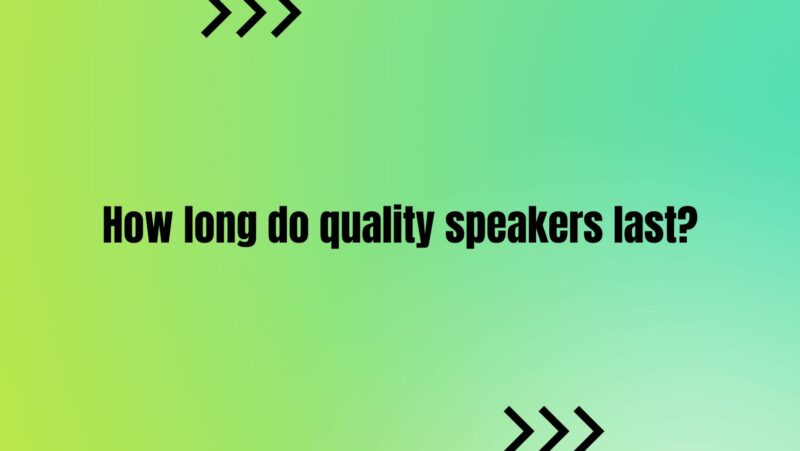In the realm of auditory enchantment, quality speakers stand as the architects of our sonic experiences. From the thunderous crescendos of symphonies to the hushed whispers of dialogue, these devices wield the power to transport us into the heart of soundscapes. As we invest in these auditory companions, a pertinent question arises: How long do quality speakers last? The pursuit of this answer traverses the domains of engineering, material science, user habits, and environmental factors. In this exploration, we embark on a journey to uncover the temporal dynamics of quality speakers and the variables that define their lifespan.
I. Constructing a Sonic Foundation: Speaker Anatomy
To unravel the lifespan of quality speakers, one must delve into their intricate architecture. The foundation of a speaker consists of several components: the diaphragm (cone or dome), voice coil, magnet assembly, and suspension system. These constituents harmoniously choreograph the transformation of electrical signals into the symphonies that grace our ears.
II. Quality in Materials: A Pillar of Longevity
A key determinant of a speaker’s lifespan is the quality of materials used in its construction. High-end speakers often feature diaphragms composed of advanced materials, such as specialized composites or exotic metals. These materials boast enhanced durability and resistance to wear, leading to prolonged performance. Likewise, the voice coil’s wire quality and insulation play a role in its endurance, resisting degradation over time.
III. The Power Equation: Performance and Longevity
The power handling capacity of a quality speaker significantly influences its lifespan. While higher power capabilities enable greater volume and dynamic range, they can also subject components to stress. When speakers are driven at or beyond their power limits, the components are strained, leading to accelerated wear. Adhering to proper power matching and avoiding excessive volume levels can extend a speaker’s functional life.
IV. Quality, Sustainability, and Environmental Factors
Environmental conditions are pivotal in dictating a quality speaker’s longevity. Humidity, temperature fluctuations, and exposure to sunlight can degrade materials and connections. Outdoor speakers, designed with weather resistance in mind, underscore the industry’s efforts to combat environmental challenges. Strategic placement and protection against harsh conditions can mitigate the impact of external factors.
V. Technological Advancements: Pushing Boundaries
The march of technology continually reshapes the lifespan of quality speakers. Advances in materials science and engineering lead to the creation of more resilient components. Additionally, protective mechanisms such as thermal sensors and overload circuits are integrated into modern designs to prevent damage. Technological innovation also paves the way for smart features, contributing to extended lifespan through adaptability and real-time monitoring.
VI. The Human Touch: User Behavior and Maintenance
Quality speaker lifespan is inextricably linked to user behavior and maintenance practices. Patterns of usage significantly affect wear. Sustained high-volume listening and playing distorted audio content can hasten component degradation. Mindful and controlled usage can mitigate this impact. Moreover, regular maintenance, including dusting and visual inspections, can extend a speaker’s functional life.
VII. Lifespan Versus Performance
The lifespan of quality speakers is intertwined with the concept of diminishing returns. While speakers can last for decades, their performance might gradually decline over time. The subtle changes in sound quality may not be immediately perceptible but can become evident with meticulous listening. The fine balance between preserving a speaker’s lifespan and maintaining optimal audio quality is a consideration for audiophiles.
VIII. Determining the Journey’s End
Despite the meticulous engineering and care, quality speakers do ultimately reach the end of their journey. The combination of wear on components, exposure to environmental factors, and the cumulative hours of operation all contribute to a speaker’s eventual decline. However, the lifespan of a quality speaker can vary significantly based on the factors discussed, spanning from several years to several decades.
Conclusion
The lifespan of quality speakers is a symphony conducted by the interplay of design, materials, technological advances, user behavior, and environmental conditions. While the march of time inevitably takes its toll, the harmonious balance between preserving performance and extending longevity remains an art. Armed with the knowledge of these intricate dynamics, we can embark on a sonorous journey that resonates with the enduring melodies of high-quality audio experiences.


